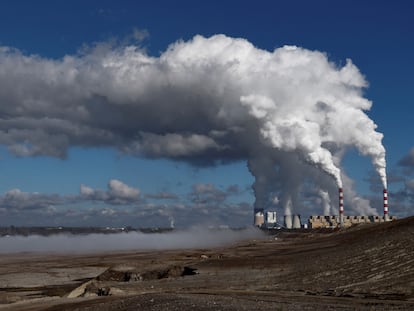Governments want to double renewables by 2030, but they need to triple them to combat the climate crisis
A study suggests that by the end of this decade, more than three-quarters of clean energy will come from solar and wind


Tripling renewable energy capacity this decade — in other words, going from 3,400 gigawatts (GW) in 2022 to 11,000 in 2030 — has become a mantra in the international fight against climate change. Achieving that goal is within the reach of mankind, according to an analysis by the Ember climate change and energy think tank. The group of experts says that at this time, the national plans that the governments of 57 countries have — which together account for 90% of the world’s energy sector — will lead to a doubling of renewable energy output in 2030, when it will reach 7,300 GW. “More than three-quarters of renewable capacity in 2030 will come from solar and wind energy,” it adds. The rest will mostly be hydroelectric energy, which is not growing at the same rate as wind and solar power technologies, whose costs have plummeted.
Since the International Energy Agency (IEA) and the International Renewable Energy Agency (IRENA) set this as a goal to comply with the Paris Agreement, the aim to triple the world’s clean energy output has taken over the international agenda. This happened at the G-20 meeting in India in September and at the energy and climate mini-summit that Spain hosted in October. Last week, China and the United States also pledged to advance that objective at the annual climate summit, COP28, which begins in Dubai on the November 30 and runs until December 12.
The analysis concludes that it is perfectly possible to meet the global objective of tripling global renewable energy, which does not mean that each country must increase its power by a factor of three, because starting from scratch is not the same as starting with a system that already generates a lot of energy from wind and solar sources. In any case, 11,000 GW of green energy is within reach at this time.
To do this, Ember points out that the world needs to increase the deployment of renewable energy by 17% each year for the remainder of the decade. “The world has already achieved this annual growth rate during the period between 2016 and 2023,” the study highlights. But analysts believe that there is still a disconnect between national plans and the speed that the sector is growing. “Governments must increase their ambitions and set objectives that reflect the true growth rate of the renewable energy market in their respective countries,” they explain. Because “the current boom in renewable energy is already exceeding the growth anticipated by governments.”
The experts point to a group of 10 countries that aimed to triple their capacity by 2022, among which are India and Saudi Arabia. The report now places Spain among the group of 12 countries whose pace of implementing renewables, if it is maintained, will lead them to comfortably exceed the target they have set for 2030. And it highlights four countries in particular that can easily raise their targets: Australia, Japan, South Korea, and the United Arab Emirates.
The United Arab Emirates is the host of this year’s climate summit, in addition to being one of the largest producers and financiers of fossil fuels. And that is the other key to this story of the transition to a world free of greenhouse gas emissions.
To comply with the Paris Agreement and keep global warming within the safest limits possible, it is not enough to simply triple the world’s renewable energy output. According to the IEA, it is also necessary to double efficiency, which means reducing energy consumption. And, as the U.N. Secretary General, António Guterres, recalled this Monday, “the world needs to chart a course to stop using fossil fuels,” meaning coal, oil, and natural gas.
Guterres has stressed that, to comply with the Paris Agreement, it is necessary to “tear out the poisoned root of the climate crisis: fossil fuels.” However, a recent report sponsored by the U.N. warned that fossil fuel-producing countries still plan to increase coal, oil, and natural gas production in the coming decades. If these projections come true, it will be impossible to comply with the Paris Agreement, whose main objective is that the increase in temperature does not exceed two degrees Celsius with respect to pre-industrial levels and, to the extent it is possible, not to exceed an increase of 1.5 degrees.
Sign up for our weekly newsletter to get more English-language news coverage from EL PAÍS USA Edition
Tu suscripción se está usando en otro dispositivo
¿Quieres añadir otro usuario a tu suscripción?
Si continúas leyendo en este dispositivo, no se podrá leer en el otro.
FlechaTu suscripción se está usando en otro dispositivo y solo puedes acceder a EL PAÍS desde un dispositivo a la vez.
Si quieres compartir tu cuenta, cambia tu suscripción a la modalidad Premium, así podrás añadir otro usuario. Cada uno accederá con su propia cuenta de email, lo que os permitirá personalizar vuestra experiencia en EL PAÍS.
¿Tienes una suscripción de empresa? Accede aquí para contratar más cuentas.
En el caso de no saber quién está usando tu cuenta, te recomendamos cambiar tu contraseña aquí.
Si decides continuar compartiendo tu cuenta, este mensaje se mostrará en tu dispositivo y en el de la otra persona que está usando tu cuenta de forma indefinida, afectando a tu experiencia de lectura. Puedes consultar aquí los términos y condiciones de la suscripción digital.
More information
Últimas noticias
Most viewed
- Oona Chaplin: ‘I told James Cameron that I was living in a treehouse and starting a permaculture project with a friend’
- Sinaloa Cartel war is taking its toll on Los Chapitos
- Reinhard Genzel, Nobel laureate in physics: ‘One-minute videos will never give you the truth’
- Why the price of coffee has skyrocketed: from Brazilian plantations to specialty coffee houses
- Silver prices are going crazy: This is what’s fueling the rally










































